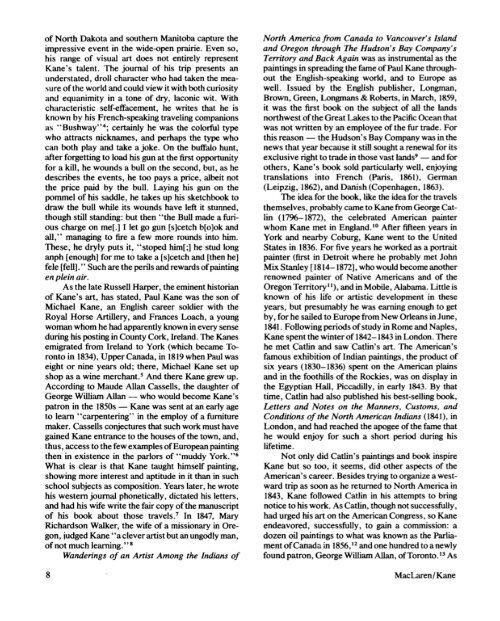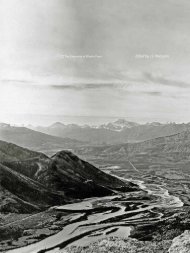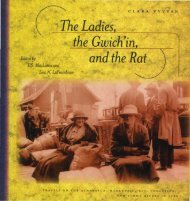Paul Kane's Journal of his Western Travels, 1846-1848 - History and ...
Paul Kane's Journal of his Western Travels, 1846-1848 - History and ...
Paul Kane's Journal of his Western Travels, 1846-1848 - History and ...
You also want an ePaper? Increase the reach of your titles
YUMPU automatically turns print PDFs into web optimized ePapers that Google loves.
ngman<br />
<strong>of</strong> North Dakota <strong>and</strong> outhem Manitoba capture the<br />
impre ive event in the wide-open prairie. ven 0,<br />
hi ' range <strong>of</strong> vi uaJ art does not entirely repre ent<br />
Kane s talent. The journaJ <strong>of</strong> hi trip pre ent an<br />
understated, droll chal~acter who had taken the measure<br />
<strong>of</strong> the world <strong>and</strong> could view it with both curio ity<br />
<strong>and</strong> equanimity in a tone <strong>of</strong> dry, laconic wit. With<br />
characteristic self-effacement, he writes that he is<br />
known by <strong>his</strong> French-speaking traveling companion<br />
a ' .. Bushway" 4; certainly he was the colorful type<br />
who attracts nicknames, <strong>and</strong> perhaps the type who<br />
can both play <strong>and</strong> take a joke. On the buffalo hunt,<br />
after forgetting to load <strong>his</strong> gun at the first opportunity<br />
for a kill, he wounds a bull on the second. but as he<br />
describes the events, he too pays a price, albeit not<br />
the price paid by the bull. Laying <strong>his</strong> gun on the<br />
pommel <strong>of</strong> <strong>his</strong> saddle, he takes up <strong>his</strong> sketchbook to<br />
draw the bull while its wounds have left it stunned,<br />
though still st<strong>and</strong>ing: -but then "the Bull made a furious<br />
charge on me[.] I let go gun [ ]cetch b[ 0 ]ok <strong>and</strong><br />
aD, " managing to fire a few more rounds into him.<br />
These, he dryly puts it, 'stoped him[;] he tud long<br />
anph [enough] for me to take a [s]cetch <strong>and</strong> [then he]<br />
fe1e [fell]. " Such are the perils <strong>and</strong> rewards <strong>of</strong> painting<br />
en plein air.<br />
As the late Russen Harper, the eminent <strong>his</strong>torian<br />
<strong>of</strong> <strong>Kane's</strong> art, has stated, <strong>Paul</strong> Kane was the son <strong>of</strong><br />
Michael Kane, an English career soldier with the<br />
Royal Horse Artillery, <strong>and</strong> Frances Loach, a young<br />
woman whom he had apparently known in every sense<br />
during <strong>his</strong> posting in County Cork, Irel<strong>and</strong>. The Kanes<br />
emigrated from Irel<strong>and</strong> to York (which became Toronto<br />
in 1834), Upper Canada, in 1819 when <strong>Paul</strong> was<br />
eight or nine years old; there, Michael Kane set up<br />
shop as a. wine merchant. S And there Kane grew up.<br />
According to Maude Allan Cassells, the daughter <strong>of</strong><br />
George William AJJan - who would become <strong>Kane's</strong><br />
patron in the 1850s - Kane was sent at an early age<br />
to learn "carpentering" in the employ <strong>of</strong> a fumirure<br />
maker. Cassells conjectures that such work must have<br />
gained Kane entrance to the houses <strong>of</strong> the town, <strong>and</strong><br />
thus, access to the few examples <strong>of</strong> European painting<br />
then in existence in the parlors <strong>of</strong> "muddy York."6<br />
What is clear is that Kane taught himself painting,<br />
showing more interest <strong>and</strong> aptitude in it than in such<br />
school subjects as composition. Years later. he wrote<br />
<strong>his</strong> western journal phonetically, dictated <strong>his</strong> letters,<br />
<strong>and</strong> had <strong>his</strong> wife write the fair copy <strong>of</strong> the manuscript<br />
<strong>of</strong> <strong>his</strong> book about those travels. 7 In 1847. Mary<br />
Richardson Walker, the wife <strong>of</strong> a missionary in Oregon,<br />
judged Kane '"a clever artist but an ungodly man,<br />
<strong>of</strong> not much learning. " 8<br />
W<strong>and</strong>erings <strong>of</strong> an Artist Among the Indians <strong>of</strong><br />
8<br />
North America from Canada to Vancouver' ll<strong>and</strong><br />
<strong>and</strong> Oregon through The Hudson's Bay Company's<br />
Territory <strong>and</strong> Back Again w as in trom ntal as th<br />
painting in preading the fame <strong>of</strong> <strong>Paul</strong> Kane throughout<br />
the Eogli h- peaking world, <strong>and</strong> to urope as<br />
well. Issued by the nglish publisher I<br />
Brown, Green ngmans & Robert in March 1859<br />
it was the first book on the ubject <strong>of</strong> all the l<strong>and</strong>s<br />
northwest <strong>of</strong> the Great Lakes to the Pacific Ocean that<br />
was not written by an employee <strong>of</strong> the fur trade. For<br />
thi reason - the Hud on Bay Company was in the<br />
news that year because it still . oUght a renewal for i<br />
exclusive right to trade in those vast l<strong>and</strong>s' - <strong>and</strong> for<br />
others, <strong>Kane's</strong> book old particularly well enjoying<br />
tran lations into French (Paris, 1861) German<br />
(Leipzig, 1862), <strong>and</strong> Danish (Copenhagen 1863 .<br />
The idea for the book, like the idea for the travel<br />
them elves probably came to Kane from George Catlin<br />
(1796- ]872), the celebrated American painter<br />
whom Kane met in Engl<strong>and</strong>. 10 After fifteen years in<br />
York <strong>and</strong> nearby Coburg Kane went to the ruted<br />
States in 1836. For five years he worked as a portrait<br />
painter (first in Detroit where he probably met John<br />
Mix Stanley [1814-1872], who would become another<br />
renowned painter <strong>of</strong> Native Americans <strong>and</strong> <strong>of</strong> the<br />
Oregon Territory ll), <strong>and</strong> in Mobile, Alabama. Little is<br />
known <strong>of</strong> <strong>his</strong> life or artistic development in these<br />
years, but presumably he was earning enough to get<br />
by, for he sailed to Europe from ew Orleans in June<br />
1841. Following periods <strong>of</strong> study in Rome <strong>and</strong> aple<br />
Kane spent the winter <strong>of</strong> 1842-1843 in London. There<br />
he met Catlin <strong>and</strong> saw Catlin s art. The American s<br />
famous exhibition <strong>of</strong> Indian paintings, the product <strong>of</strong><br />
six years (1830-1836) spent on the American plains<br />
<strong>and</strong> in the foothills <strong>of</strong> the Rockies, was on display in<br />
the Egyptian Hall, Piccadilly, in early 1843. By that<br />
time, Catlin had also published hi best-selling OOok<br />
Letters <strong>and</strong> Notes on the Manners, Customs, <strong>and</strong><br />
Conditions <strong>of</strong> the North American Indians (1841) in<br />
London, <strong>and</strong> had reached the apogee <strong>of</strong> the fame that<br />
he would enjoy for such a short period during <strong>his</strong><br />
lifetime.<br />
Not only did Catlin's paintings <strong>and</strong> book inspire<br />
Kane but so too it seems, did other aspects <strong>of</strong> the<br />
American's career. Besides trying to organize a westward<br />
trip as soon as he returned to North America in<br />
1843. Kane followed Catlin in <strong>his</strong> attempts to bring<br />
notice to <strong>his</strong> work. As Catlin. though oot successfully<br />
had urged <strong>his</strong> art on the American Congress so Kane<br />
endeavored, successfully to gain a commission: a<br />
dozen oil paintings to what was known as the Parliament<br />
<strong>of</strong> Canada in 1856,12 <strong>and</strong> one hundred to a newly<br />
found patron, George William Allan, <strong>of</strong> Toronto. 13 As<br />
MacLaren/ Kane
















